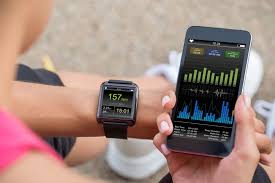Advertisements
Transforming the way we view health has been one of the great revolutions of the 21st century. With the incessant advancement of technology, new tools and solutions are emerging, offering innovative ways to promote well-being and improve quality of life. In this context, exploring how technology is changing the healthcare landscape becomes essential for those seeking a more balanced and healthy lifestyle. 🌟
The integration of smart devices and apps for personal monitoring is becoming increasingly common. From wearables that track daily physical activity to apps that help with meditation and stress management, technology is playing a vital role in promoting healthy habits. In addition, telemedicine is emerging as a powerful tool, facilitating access to quality medical care regardless of geographic location.
Advertisements
The advancement of artificial intelligence and big data technologies is also bringing impressive innovations. These systems are being used to predict disease outbreaks, personalize treatments, and even develop new drugs. This movement not only promises to transform the way we understand and treat diseases, but also offers opportunities for more effective and personalized preventive medicine.
In addition to the innovations already in practice, many more are on the horizon. 3D printing of prosthetics, robotics in complex surgeries, and virtual reality for medical training are just some of the promises that will shape the future of healthcare. The intersection of technology and medicine is not only improving treatments, but also creating more integrated and accessible healthcare experiences.
Advertisements
The impact of these technologies extends beyond the doctor’s office, directly affecting people’s daily lives. The democratization of health information and patient empowerment are direct results of this digital revolution. By understanding and embracing these innovations, we are not only reinventing our healthcare, but also shaping a future where well-being is increasingly accessible to everyone. 🚀

The Impact of Technology on Health and Wellbeing
Technology has transformed the way we look at health care and well-being, bringing innovations that facilitate access to information and tools that were previously unimaginable. With a simple touch on your cell phone screen, you can access a universe of resources that promote a healthier and more balanced life. This technological advancement offers solutions that range from health monitoring apps to wearable devices that help control chronic conditions.
Wearable Devices and Personal Monitoring
A Closer Look at Our Health
Wearable devices, such as smartwatches and fitness trackers, have become constant companions in our lives. They provide real-time data on our sleep patterns, heart rate, physical activity levels, and more. With this information, we can immediately adjust our habits, promoting continuous improvements in our health.
Personalization and Constant Monitoring
The ability to customize the functions of these devices allows each user to have monitoring tailored to their specific needs. This is especially beneficial for people who require constant monitoring due to pre-existing medical conditions. Technology gives us the power to always be aware, and this continuous monitoring can be crucial for the prevention and early detection of health problems.
Health and Wellness Apps
Facilitating Access to Health Information
Health apps are revolutionizing access to information. They offer content ranging from nutrition and exercise tips to guided meditations and stress management programs. This democratization of knowledge allows more people to make informed decisions about their health.
Recommended Articles
Interactivity and Online Support
In addition to information, many apps offer online interactivity and support. Discussion forums, Q&A sessions with experts, and even virtual consultations are available to help users feel supported on their wellness journey. This virtual connection provides a sense of community and belonging, which can be essential for continued motivation.
Telemedicine and the Future of Healthcare
Fast and Efficient Access to Healthcare Professionals
Telemedicine has emerged as a viable solution to the logistical challenges of healthcare. With online medical consultations, it is possible to reduce waiting times and travel times, allowing for faster access to healthcare professionals. This is especially important in remote areas or for people with reduced mobility.
Personalized Care and Continuity of Service
Through telemedicine, care can be more personalized, with doctors having access to data from wearable devices and health apps. This continuity of care, which integrates information from multiple sources, ensures more cohesive and efficient care, focused on the individual needs of the patient.
The Internet of Things (IoT) in Healthcare
Connectivity and Device Integration
The Internet of Things (IoT) is connecting diverse devices, creating an integrated healthcare ecosystem. Medical devices, wearables, and even home appliances can communicate with each other to provide a comprehensive picture of a user’s health. This connectivity can lead to more accurate diagnoses and more effective treatments.
Automation and Proactive Prevention
With the automation enabled by IoT, many routine healthcare procedures can be performed autonomously, such as checking vital signs and scheduling routine exams. This frees up healthcare professionals’ time to focus on more complex tasks and enables a more proactive preventive approach, identifying risks before they become major problems.
Artificial Intelligence and Machine Learning
Innovation in Diagnosis and Treatment
Artificial intelligence (AI) and machine learning have shown immense potential in healthcare. Advanced algorithms are able to analyze vast amounts of data to identify patterns that may not be apparent to the human eye. This is leading to more accurate diagnoses and new personalized treatment methods.
Virtual Assistants and Patient Support
Virtual assistants, such as chatbots, are increasingly present in patient support, offering real-time guidance and information. They can answer basic questions, help with scheduling appointments and remind patients about medication administration, becoming valuable allies in the day-to-day healthcare process.
Virtual and Augmented Reality in Well-Being
Immersive Experiences for Rehabilitation and Stress Relief
Virtual reality (VR) and augmented reality (AR) are transforming the way we approach rehabilitation and stress relief. VR programs allow patients to participate in physical therapy sessions in a controlled virtual environment, while AR can be used to create calming experiences that help reduce stress and anxiety.
Health Education and Training
These technologies are also valuable for healthcare education, allowing both professionals and patients to learn in an interactive and engaging way. Virtual reality simulations can train doctors in complex procedures, while augmented reality experiences can help patients better understand their conditions and treatments.
Challenges and Ethical Considerations
Data Privacy and Security
As technology in healthcare increases, concerns about the privacy and security of patient data arise. Ensuring that this information is protected is essential to maintaining user trust and ensuring that technology is used responsibly.
Accessibility and Digital Inclusion
Another challenge is ensuring that these innovations are accessible to all. Disparities in access to technology can exacerbate existing health inequalities. It is essential that technological developments take digital inclusion into account, ensuring that everyone can benefit from these innovations.
How Technology Is Redefining Mental Health
Mental Wellness Apps
Mental health support apps are becoming a vital part of self-care. They offer features like guided meditations, mindfulness exercises, and mood tracking, allowing users to monitor and improve their mental well-being in a practical way.
Telepsychology and Expanded Access to Therapy
Telepsychology is breaking down barriers by making access to therapy easier and more convenient. Online sessions offer flexibility and convenience, allowing more people to seek professional help for mental health issues.
- Wearable devices that monitor vital signs
- Apps that offer mindfulness exercises
- Virtual reality for physiotherapy sessions
- Artificial intelligence for accurate diagnostics
- Telemedicine for remote medical consultations
Conclusion
In conclusion, the technological revolution in the health and wellness sector is redefining how we care for ourselves and others. With the incorporation of wearable devices, health apps, telemedicine, IoT, artificial intelligence, virtual and augmented reality, we have a range of tools that facilitate more effective monitoring, diagnosis and treatment. Not only do we have access to valuable information at the touch of a button, but we can also customize these tools to suit our specific needs, making healthcare more accessible and convenient. 🌟
Furthermore, the democratization of knowledge through health apps empowers users to make informed decisions about their conditions. This is vital to fostering a culture of prevention and ongoing well-being. Telemedicine, in turn, breaks down geographical and mobility barriers, providing fast and efficient access to healthcare professionals, something essential in times of pandemic and beyond.
However, as we navigate these innovations, we must be mindful of ethical challenges such as data privacy and digital inclusion. Protecting patient information and ensuring technology is accessible to all are critical to building trust and equity in healthcare.
So the future of healthcare is promising, but it requires a careful balance between innovation and responsibility. By embracing these technologies consciously, we can truly revolutionize our health and well-being, living longer, healthier lives. 🚀




